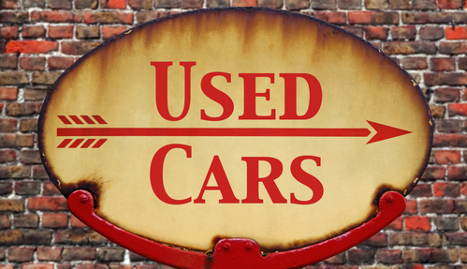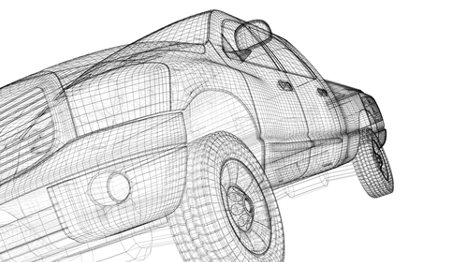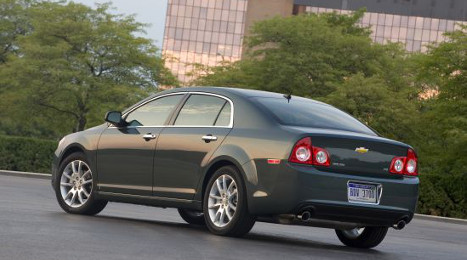The top segment at the auction, in terms of price increases, during the last month of 2014 was the midsize car, but it was the No. 2 segment on the list that had analysts with Kelley Blue Book a bit surprised, given the fuel-price climate.
With an 0.8-percent hike in auction price, the subcompact car trailed only the midsize car (up 0.9 percent) in the rankings of the five best-performing segments (based on increases in Kelly Blue Book Auction Value for 2011–2013 model-year vehicles).
This occurred amid average gas prices falling to a new national low of $2.49 per gallon in December, KBB said, citing data from the U.S. Energy Information Administration.
“The real surprise came from the strength we’re seeing in the subcompact car segment,” KBB analyst Sean Foyil said in the latest Blue Book Market Report from KBB. “Typically, as fuel prices dip, we see the more fuel-efficient segments take the largest hit, and with fuel prices reaching a three-year low, it’s surprising to see the smaller vehicles holding demand.”
Perhaps just as odd is what happened in the midsize car segment: prices were up even though auction volume for the midsize car segment increased, as well, according to the report.
After the midsize and compact cars, the next strongest segment gains in the top five rankings were for the compact SUV/crossover and compact cars (both up 0.6 percent), followed by the luxury compact SUV/crossover (up 0.4 percent).
Conversely, the biggest declines were seen in the sporty compact cars (down 7.1 percent), followed by the electric vehicles (down 3.8 percent), minivans/vans (down 2.1 percent), high-performance cars (down 2.0 percent) and luxury cars (down 1.8 percent).
One of the segments that KBB found to be stable last month was the full-size truck. Its auction values in December showed just a 0.9-percent month-over-month decline and were ahead 3.0 percent year-over-year, even though the housing construction market had softened a bit the month before.
Specifically, KBB said the seasonally adjusted annual rate for privately owned housing units at the end of November was 0.2 percent softer than a year earlier and 1.4 percent weaker than a month earlier.
It was also the first time in six months that the housing unit SAAR had dipped on a year-over-year basis, the report said.
So why did full-size values remain so calm? KBB suggests it could have something to do with the low fuel costs mentioned earlier and models like the revamped Ford F-150 bringing some buzz to the segment.
December is throwing some curveballs in the lanes. As commentary from Black Book personnel at auction flowed in last week, it became clear “the market is not acting in typical December fashion.”
That’s according to Black Book editorial director Ricky Beggs, who highlighted some unusual movement for auction prices this past week in his latest “Beggs on the Used Car Market” video report.
“Sellers are more willing to move the product, and buyers are not just buying for today’s end of the year retail push, but aggressively going after inventory that will meet the needs of the tax refund buyers of February, March and April,” Beggs said of last week’s action in the lanes.
And as we move closer toward winter, Beggs said it is all about trucks and four-wheel drive SUVs — and high demand is making for unusually slight depreciation among these segments.
The truck segments saw an average decline of $26 last week, with several segments seeing increases in value.
Both of the full-size van segments, along with the compact pickups and the compact SUVs saw prices rise slightly.
The full-size pickups and the midsize SUVs saw a slight drop of $5, while the full-size SUVs fell by $9.
“It is all about trucks and 4X4 SUVs. If I was a seller and needed to move inventory I would hope to have a stronger mix of those type units. The activity and prices of these was the main focus of the reports from the Southwest, Western Coast, Northwest, Midwest and Southeast,” said Beggs. “About the only area of the country not referencing this was the Northeastern part of the country.”
On the car side of the market, price trends were unusual for this time of year, as well. The $37 average decline among cars this past week was the lowest weekly depreciation rate since the week ending May 2.
The lowest weekly decline was posted for the entry level cars, compact cars and entry midsize cars, which all fell by $15 or less.
“These segments have also been the better performing segments consistently over the past few years during the first quarter of the year. We see this as another sign of the tax season pulling ahead,” Beggs said.
“So as you see, the finished adjustments confirm that it is an unusual market for the early part of December. We still have one more full week of auction activity before the holiday weeks,” he concluded.
See above for the latest “Beggs on the Used Car Market” video report.
Last month brought with it higher prices in the lanes, and even though overall used supply is expected to expand in the coming months, seasonal tightening was perhaps the culprit for the rate spikes in November.
According to NADA Used Car Guide, auction prices for vehicles up to 8 years in age fell by 1.3 percent in November, which is much lower than the numbers traditionally recorded for the month.
NADA analysts pointed out this past month also ended a four-month streak of depreciation rates at or above 3 percent.
NADA’s seasonally adjusted used-vehicle price index rose by about 2 points from October, bringing the index to rest at 123. Last year, during the same period, the index had jumped to 124.
According to the latest NADA Used Car Guide’s latest Guidelines report, strong demand in the used market as well as a decrease in vehicles at auction led to November’s price increases.
Jonathan Banks, executive analyst for the NADA Used Car Guide said, "Usually wholesale auction volume decreases during this time of year ― and it did, again. This time, however, it fell even a bit more than normal. If there are less used vehicles in the marketplace, then competition increases, and values hold a little better as a result."
Auction volume for vehicles up to 8 years in age dropped by 9 percent in November, which is 2 points above the 7-percent drop recorded during the same month last year.
Volume tightening was most noticeable among rental-heavy 2014 model-year vehicles, Banks pointed out; volume for this market segment fell by almost 10 percent in November.
Wholesale prices dropped the most for mid-size vans last month, which saw a 2.6-percent drop. Subcompact cars also fell above the industry average, dropping by 1.6 percent.
All other segments held stronger-than-average retention. Compact and midsize car prices fell by 1.2 and 1.1 percent, respectively.
And as we approach winter, prices were even stronger for mainstream truck and SUV brands; these segments only saw prices fall within the range of 0.9 to 0.4 percent.
NADA UCG reported although prices have dropped this fall, auction prices are still 1.1 percent higher than they were through November of 2013.
This month, NADA UCG expects seasonality to play a role, as well, with prices expected to fall by 1.5 percent, which Banks says is a “normal dip for the time of year.”
“The drop in prices can be attributed to poor performance within the compact and luxury car segments, the biggest forecasted losers for the month,” Banks said in the report.
Compact car and utility segments are expected to see above-average depreciation, as well, while declines for mid-size cars and most other truck segments are predicted to see depreciation at or below the average, NADA UCG reported.
Following the same trend seen throughout most of the year, pickup prices are expected to see the least depreciation this month.
Looking ahead to the new year, NADA UCG predicts prices will follow seasonal patterns and increase through the first quarter before dropping across the remainder of the year.
As supply continues to expand, auction and retail prices of used vehicles are expected to take a downward turn.
And the second half of the year has brought with it signs of a price turnaround on the lots — which will perhaps serve to bring more used shoppers into dealerships this holiday season.
Though many shoppers are too busy buying holiday gifts to focus on a purchase as big as a vehicle, the following statistic might turn some heads: According to third-party site CarGurus’ Used Price Index, used-car prices have dropped 5.4 percent since their May high.
The average price of a used car is now $18,469, according to the site. This downward movement reflects what CarGurus’ analysts are calling a seasonal trend and project prices will continue to drop by as much as 2 percent through the end of January.
“For used-car shoppers, it really is the most wonderful time of the year to find a great deal,” said Dave Galvin, director of data analytics for CarGurus.
The site reported the primary driver of recent used-price declines is a seasonal decline in shopper demand. While spring and summer months normally bring high used sales activity, the second half of the year is traditionally quite a bit slower.
Consequently, dealers are adjusting prices accordingly in an effort to attract potential buyers and make room for inventory in the new year.
Cargurus analysts also noted “consumer shopping interest typically comes back strong by January, and prices follow, rising again in February.”
After a February bump, used prices are expected to continue increasing through tax season.
Though most dealers are used to wholesale prices falling right along with the leaves, the tides turned a bit this past November.
According to ADESA Analytical Services’ monthly analysis of wholesale used vehicle prices by vehicle model class, wholesale prices rose by 1.8 percent compared to October.
The average price of $9,862 in the lanes this past month was also up 1.1 percent year-over-year.
“November wholesale used-vehicle prices displayed a continuation of the recent trend toward a richer mix of late-model vehicles that have biased average prices upward,” ADESA chief economist Tom Kontos said in the latest edition of Kontos Kommentary.
Kontos also pointed out that strength in the used-car market is keeping wholesale prices elevated, even amidst well-performing new-vehicle sales.
“Retail used-vehicle sales, especially for certified pre-owned vehicles, provided demand-side price support at a time when high off-lease volumes and trade-ins from strong new vehicle sales could have pushed average prices down,” Kontos said of the November price movement in the lanes.
Used unit sales soared in November to 3.11 million, according to CNW research, up from 3.10 million used sales during the same period of 2013. This past month's success pushed year-to-date figures for used sales well above 38 million.
Last month, full-size SUVs and luxury cars touted some of the strongest month-over-month price gains in the lanes, according to ADESA data.
Prices for full-size SUVs were up 5.3 percent from October rates, coming in at an average of $11,695 in November.
“Low gasoline prices may have contributed to this result,” Kontos said, as prices at the pump dipped below $3 in November and continued falling.
Luxury cars also saw a significant price boost last month, with rates rising to an average of $12,166, up 4.8 percent from October.
Manufacturers enjoyed the biggest price bump at auction last month, with remarketing prices up 4.1 percent from October. That said, rates for automakers were down 8.1 percent year-over-year — perhaps not surprising as used supply continues to expand.
Prices for fleet/least consignors were up 0.3 percent sequentially, but down 2.1 percent annually, Kontos pointed out. He said prices for off-rental “risk” units held up well for this segment considering the recent boost in volume of these vehicles that are being remarketed this late in the year.
“This could be due to the curtailment of sales for selected off-rental program vehicles until after the new year,” Kontos said.
And dealer consignors were also bringing in a little more cash, with prices in the lanes rising by 1.4 percent from October and 1.5 percent year-over-year. Kontos said this trend indicates “the wholesale market is readily absorbing excess dealer trades.”
Winter is only a few weeks away, but if last week’s price movement is any indicator, it feels a bit more like spring in the auction lanes.
Prices at auction last week showed the lowest depreciation rates in months, illustrating price movement seen more often closer to tax season.
Black Book editorial director Ricky Beggs said in latest “Beggs on the Used Car Market” video report that the easing depreciation this past week “shows a level of change not familiar for this time of the year” that could be related to strength of new-car sales.
Both trucks and cars are seeing depreciation well below year-ago levels.
The cars saw prices fall by an average of $40, while the trucks only saw a $12 decline last week. During the same period of 2013, cars fell by $34, and trucks fell by $50.
Last week’s movement also marks the lowest level of depreciation since the week of May 2.
Taking a look at the individual segment movement for cars, the entry-level segment was the only one to see an increase, with prices rising by $14. The compact cars also performed well with a decline of only $17.
“The levels of change of these segments are not a surprise until we look at the price of gas at the pump. It fell by another 4 cents this past week to be at $2.78,” Beggs said. “Our first thought is the beginning of dealers trying to find inventory for the soon to be here tax season, that is just ignoring the four-year record low gas prices.”
The trucks, though, have also seen average depreciation ease each of the past four weeks.
The full-size vans, both cargo and passenger designs, saw prices rise by $34 last week.The compact SUVs also saw a spike, with prices rising by $21.
The pickup trucks also continue to perform well: the full-size pickups rose by $7, while the compact pickups saw prices increase by $8.
And the luxury SUVs and full-size crossovers experienced a significant shift this past week in price movement.
Two weeks ago, both segments saw declines of over $100. This past week, the luxury SUVs and full-size crossovers saw price declines of only $37 and $29, respectively.
“There could be retail interest for these larger utilities due to the four year low gas prices,” Beggs concluded.
The full video report can be seen above.
The upturn in wholesale vehicle prices “showed a more sizable gain” in November, according to the latest update of the Manheim Used Vehicle Value Index.
After ticking up in October, Manheim determined the movement of wholesale used-vehicle prices (on a mix-, mileage- and seasonally adjusted basis) pushed the November index reading to 123.3, which represented an increase of 0.7 percent from a year ago.
“Wholesale price movements since April suggest that, if there was a price misalignment between new and used vehicles, it was modest at best,” Manheim chief economist Tom Webb said.
“The five-month decline in pricing lowered wholesale values by less than 3 percent, and the subsequent two-month rise has brought prices within 1.3 percent of their April high,” Webb continued.
“Recent wholesale pricing also suggests that the low- to mid-16 million new-vehicle SAAR in September and October did not create the level, or age/model/condition mix, of trade-ins and lease turn-ins that dealers needed for today’s robust used-vehicle market. The dealer’s mood in November was one of active acquisition at auction,” he went on to say.
Four of the six vehicle segments Manheim tracks for its index report moved higher in November. On a year-over-year comparison, prices for pickups led the charge higher by rising 6.2 percent, followed by vans (up 2.1 percent), luxury cars (up 1.4 percent) as well as CUVs and SUVs (up 1.4 percent).
In particular, that luxury-car price metric caught Webb’s attention.
“Luxury vehicles continued to outperform the overall market in November; but due to weakness earlier in the year, they still have a lot ground to make up,” Webb said.
“Maintaining luxury car residuals in the months ahead will be important due to the current, and upcoming, seasonal rise in lease returns in this segment,” he continued. “Pricing in the compact car market remained competitive in both the new- and used-vehicle markets.”
Keeping the overall price reading from going higher was the softening of the remaining two segments as midsize car prices dipped by 0.9 percent while compact car prices dropped by 2.5 percent.
Reviewing the wholesale market as whole, Webb said, “Our analysis of changes in mileage by price tier suggests that vehicles in the $8,000- to $10,000-price range are showing the weakest demand, whereas vehicles in the $13,000- to $15,000-range are enjoying the strongest relative pricing.
“Dealer-consigned units at auction had a 1-percent increase in average selling price despite a 2-percent rise in average mileage,” he added.
Rental-Risk Vehicle Update
Manheim indicated the average mileage on rental-risk units moving down the lanes in November crossed the 45,000-mile threshold for the first time ever.
Along with that development, Webb shared his assessment of the rental-risk market by stating it enjoyed a “bounce-back” in pricing.
Manheim determined average auction prices for rental risk units (both adjusted and unadjusted for mileage and mix shifts) moved up in November relative to October, but were still down year-over-year.
“In hindsight, we can now see that October’s sharp downward movement was exaggerated by heavy volumes and a greater share of below-average condition vehicles,” Webb said.
“November’s auction volume of rental risk units was up significantly from a year ago,” he continued. “But due to the normal large seasonal reduction, November was still the lowest-volume month of the year.”
November Sales Recap
Beginning on the used side, Webb recapped CNW Research data that showed used-vehicle retail sales by dealers ticked up by less than 1 percent in November, after declining in October.
Although year-to-date used-vehicle sales by dealers are down 1.1 percent, Webb emphasized that all indications show profits are being generated at record levels.
“Growing lease turn-ins, as well as newer trade-ins, have significantly raised the average used-vehicle selling price at franchised dealers,” Webb said.
“Relatedly, another strong month of CPO sales in November pushed the year-to-date tally to 2.14 million, an increase of 10.2 percent from the year-ago period,” he added.
On the new-vehicle side, Webb pointed out that new cars and light duty trucks sold at a seasonally adjusted annual rate of 17.1 million in November.
“That pace might have been artificially boosted by the selling day adjustment and higher fleet sales, but still it was a solid report,” Webb said.
The average new-vehicle transaction price rose to $33,754 in November, up 1.7 percent from a year ago, according to Kelley Blue Book.
“Maintaining that pricing strength over the course of the coming year may prove challenging,” Webb said. “Clearly, the expected plateauing in new-vehicle sales, the significant weakening of the yen, and the large amount of dry powder that manufacturers have to raise incentives could lead to aggressive pricing next year.
“And don’t forget the usual year-end step-up in promotions that will occur this month,” he added.
Used-vehicle depreciation may not have eased as much as expected this past month, after October brought with it significant price declines of 2 percent.
According to Black Book data the average price of a used vehicle for model years 2009-2013 still depreciated by 1.9 percent in November, down only slightly from October rates.
Domestic cars and trucks saw the largest drops last month, with prices falling by 2.2 percent for both market segments.
Import cars fell by 1.8 percent, and import trucks followed with a decline of 1.6 percent.
And though depreciation remained relatively consistent, one trend reversal will stand out to those who have been following prices in the lanes.
The full-size pickup segment, which had seen prices remain strong during most of the year, saw the largest monthly depreciation out of all vehicle segments with a drop of 3 percent. This segment ended the month with an average price tag of $25,784, a 7-percent decline from year-ago levels.
Interestingly, as depreciation stuck around the lanes last month, truck segments, overall, saw the largest monthly price drop of 2.2 percent, as well.
And though the full-size pickups took a bit of a hit last month, a few other truck segments are seeing strong price performance, with lower gas prices turning many consumers’ eyes toward some of the larger, less fuel efficient rides.
For example, the midsize pickups saw the lightest monthly depreciation rate for trucks, with only a 0.6-percent decline. This segment finished the month with an average price of $16,860, a 6.8-percent drop year-over-year.
And the full-size passenger vans even saw a price increase of 0.9 percent.
The midsize SUVs (down 0.9 percent) and the compact pickups (down 1.4 percent) also finished with lower-than-average depreciation rates.
And fuel prices at the pump are also having an impact on the car segments, pushing more fuel-efficient vehicles’ prices down.
In fact, the compact cars led the car segments with the largest monthly depreciation of 2.6 percent. That said, this is much less than October’s loss of 4.4 percent.
This segment finished November with an average price tag of $9,081, a significant 16.2 percent year-over-year drop.
On the other hand, the sporty cars were performing better in November. This segment’s decline of 1.4 percent is the strongest performance for the cars last month.
“With fuel prices falling to annual lows in November it didn’t surprise us to see weaker retention on the fuel-efficient and smaller used vehicles,” said Ricky Beggs, editorial director at Black Book. “However, overall it is surprising to see that the focus and strength of the new-car sales didn’t pull more demand from the used activity during November.”
Redesigns. Yes, this term is perhaps more exciting for the new-car market, but it seems waves of updated models impact the used market heavily, as well.
In NADA Used Car Guide’s latest white paper, titled, “How Redesigns Affect Used Vehicle Prices,” analysts discovered redesigns can play a large role in how used values pan out for models.
NADA UCG broke it down into three factors:
- The number of years since the last redesign
- Amount of competition within the vehicle’s segment
- The quality of the design
According to NADA data, 1-year-old vehicles are typically 15 to 20 percent more expensive than 2-year-old vehicles.
But for redesigned 1-year-old vehicles, add an additional 15 to 20 percent premium on top of those figures, said NADA UCG analysts.
Jonathan Banks, executive analyst for NADA UCG, offered the following example to illustrate these findings:
"Let's say you have a 2-year-old car worth $20,000. Your neighbor has the same model of car as you, but his car is only a year old, and has gone through a newer, extensive redesign. Your neighbor's car would be worth $27,000 — or about 35 percent more than yours." Banks said. "The price of the newer, redesigned 1-year-old used car holds considerably more value due to the fresher, redesigned look over your car, even though the two cars are only a year apart from one another."
According to the report, there are several factors that influence just how much redesigns can serve to push used values up.
First, lifecycle duration. In other words, products are known to become less valuable as their design becomes older and less exciting.
According to NADA UCG, on average, a model’s used value drops 1.4 percent every year it carries the same design.
But there’s a caveat.
“NADA has found that, depending on the extend of the change, more substantial refreshes can reduce but not remove the impact of design aging, while minor refreshes have no significant impact,” the report stated.
The second most influential factor that plays into the way redesigns impact used values is “competitive concentration”, the report said.
NADA analysts found that redesign value is higher amid segments with more competition on a small percentage of models, while values stay more level in segments where competition is more evenly distributed.
For example, take a look at the luxury midsize car segment. According to the report, two models out of 16 — the BMW 5 Series and Mercedes-Benz E Class — make up about 50 percent of the segment’s new sales.
On the other hand, in the compact utility segment, five models out of 20 make up 50 percent of new sales.
NADA UCG found that among the heavily concentrated segments, redesigns bumped used pricing up by 3 to 4 percent,
"Essentially, redesign impact is more significant in situations when relatively few models capture the attention of the majority of consumers because redesigns stand out much more clearly. This makes intuitive sense as well. It’s much more likely that a redesign in the hypercompetitive midsize car segment (Ford Fusion, Honda Accord, etc.) will receive less attention, and consequently generate less of an impact, than in the decidedly less competitive luxury large car segment (BMW 7 Series, Mercedes S-Class, etc.),” the report explained.
Lastly, not surprisingly, design quality plays the largest role in deciding whether redesigns will positively impact used values — though this factor is a bit more difficult to gauge. The report offers a chart outlining highly successful redesigns that illustrate the role design quality plays in greater detail.
This type of analysis will be particularly relevant next year, when a whopping 34 redesigns are expected by year-end, which beats the 22-vehicle average since 1989, NADA pointed out.
Though the holiday was cause for a short week in the lanes, Black Book’s Ricky Beggs still saw a few changing trends at auction.
For example, in his latest “Beggs on the Used Car Market” video report, the editorial director pointed out that an overall “bright spot” last week was seen among the car segments.
The overall price decline for cars came in at $56 last week, which was the lowest level of decline seen over the past five months, dating back to early July. That said, it still remains a bit above the $47 average drop for the same week last year.
The entry-level cars and upper midsize cars were the best performing car segments last week, both seeing only an $18 drop.
Beggs also noted that if you are “searching for consistent movement,” check out the near-luxury car and compact car segments, which have only seen a $4 variance over the past three weeks.
Last week, the near-luxury cars and compact cars saw prices drop by $44 and $42, respectively.
And as gas prices continued to fall last week — dropping by another 7 cents to sit at an average of $2.82 per gallon — some of the larger segments are seeing price strength as a results.
Overall, the average segment price drop for the truck segments came in at $32 last week, which is the lowest decline seen over the past eight weeks.
Beggs full report can be seen above.












